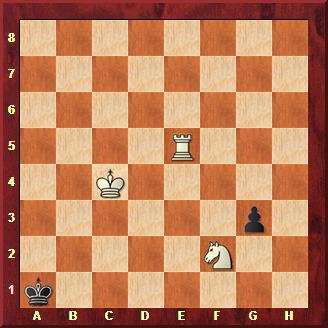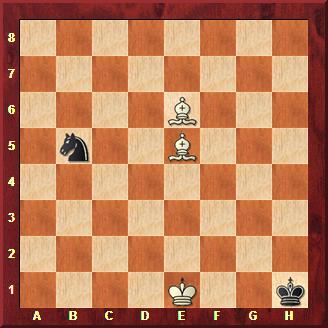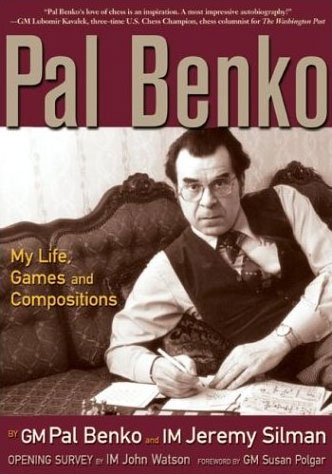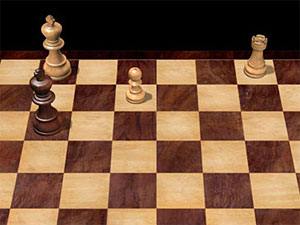Can computers compose artistic chess problems? Part two
By Pal Benkö
In part one of this article I told you how ChessBase report entitled "A machine that composes chess problems" raised my interest. In this article Dr Mohammed Azlan Iqbal presented ten selected work composed by the machine. As a problem expert I took it upon myself to comment on these examples. Here I look at a few more examples of machine composition. Once again the solutions to most of the problems are hidden and require a click to be revealed. This is in order to offer you the opportunity to try and solve them yourself, as an additionaly little benefit.
Rook promotion
Chesthetica, 20/8/2014 7:04:40 PM

White to play and mate in three: example of a computer generated chess problem
The solution 1.Rg5 Kc6 2.d8R Kb6 3.Rd6 mate. The key takes away three flight squares of the king in the first move.
Here is an alternative I composed today. It has the same material but the key move does not take away any flight squares (which is frowned in problem chess). It also produced many different mating pictures, depending on Black's defence.
Pal Benko, Original, 15.6.2016

White to play and mate in five moves
The solution: 1.f7 Ke7 (1... Ke6 2.f8=R Ke7 3.Raf5 Ke6 4.Kd8 Kd6 5.R8f6#) 2.Rf5 Ke6 (2...Kf8 3.Rf6 Kg7 4.f8=Q+ Kh7 5.Rh6#) 3. f8=R Ke7 4. R8f6 Ke8 5. Re5#.
The stalemate opportunity is already a gnawed bone. Let us see the same theme from the past:
Pal Benko, Chess Life 1977

White to play and mate in four moves
The solution 1.Kd7! Kb7 [1...Kxa7 2.Kc6!] 2.c8R! Kb6 3.a8R Kb7 4.Rcb8 mate.
I suppose that the double rook promotion was not an original idea, even as early as that time. Therefore I made it longer trying to hide the point. The degree of difficulty of the solution is not the most important, but a rather plausible first move worsens the problem value. The computer commits similar errors in the following example too.
Rook mates
Chesthetica, 24/9/2014 1:51:11 PM

White to play and mate in three moves
The solution 1.Kb3 gxf2 2.Kc2 f1Q 3.Ra5 mate. We can teach only beginners this method of mating with the rook. But it is better if we place the rook on b5. In that case 1.Kb3 gives and takes away a flight square for the black king (if 1.Kb3 Kb1 2.Rd5). It also looks better if the rook is placed on f5. Then we can even remove the knight:

The solution 1.Kb3 g2 2.Kc2 g1Q 3.Ra5 mate. It is possible to create good and neat problems with limited material but there must be something new or interesting in them.
I published the following item in my biography My Life, Games and Compositions (see below):
Pal Benko, My Life, Games and Compositions 2003

White to play and mate in nine moves
The solution: 1.Rg6! (1.Ra7? is only mate in ten) 1...Kh7 2.Rg4! Kh6 3.Kf2 Kh5 4.Kg3 Kh6 5.Kh4 Kh7 6.Kh5 Kh8 7.Kg6 Kg8 8.Rf4 Kh8 9. Rf8 mate. The computer is perfect for verifying the compositions and it has confirmed that this solution is the only one that leads to mate on move nine.
Chesthtica, 28/9/2014 3:40:07 AM

White to play and mate in three moves
The solution 1.Kf1 Nc3 2.Bg4 [2.Bh3] mate in next move. Already the first move makes the composition worthless, and there is also a dual. Here is the improvement:
Chesthtica, modification Benko

White to play and mate in five moves
The solution 1.Kf2 Ne5 2.Bh4 (zugzwang) 2...Nf3 3.Be4 Kh2 4.Bg3+ Kh3 5.Bf5 mate.
The solution is not so simple in this case. The knight offers itself to be taken twice, and that is refused by White (thematic). A new mate picture must be discovered, different from the obvious. The bishop with Be4-Bf5 makes a switchback.
All of the above was found by me after some hours search with the computer. It happened for the first time in my life that I did not create a chess problem fully in my own mind, but found part of it with a computer. Such methods are frequently used in endgames with limited material, and it has caused some controversy. In the end such compositions are recognized as having full value. This is why I am not going to take part in chess problem competitions any more. It is becoming more difficult to distinguish human work and computer output. Anyway the revolution of endgame theory started with proving two bishops versus one knight is a win.
All of the above proves that computers are unable to create artistic chess compositions without human assistance. But so far chess problems created by machines do know any of basic rules of problem composition. These rules may be ignored or broken, but there must be something valuably new in return.
I suppose that some of basic principles may be included in the programs in the future (for example not to start the solution with a check or by capturing a piece). However, the artistic content, beauty and harmony that generates pleasant feelings in humans cannot be easily input, since the computer has no feelings. We can see that this aspect is missing in their compositions.
Replay all the above problems
Select games from the dropdown menu above the board
About the author
In addition to his success as a player, Pal Benko is a noted authority on the chess endgame and a composer of endgame studies and chess problems. He is an over-the-board GM and also a FIDE IM of chess composition. The only other person we know who has these two titles is Jan Timman of the Netherlands.
Pal Benkois also a dear friend who keeps in touch with us regularly, sending problems and puzzles for the ChessBase news page on special occasions.
 |
This biography is a celebration of a great man's creative legacy, an amazing collection of 138 deeply annotated games which have been carefully prepared to be entertaining, enlightening, and instructive. They are brought to life by Benko's memoirs of his early years in war-torn Hungary, a world of poverty, chaos, pain, and ultimately, personal triumph. His insights into famous grandmasters transform legends into real people with substance and personality, and his reminiscences of famous tournaments take us on a journey through chess history unlike anything that's been published before. A massive survey of Benko's openings shows us the scope of his theoretical contributions to the game. Photos abound, and 300 of Benko's chess compositions allow lovers of the game to become intimately acquainted with a strikingly beautiful aspect of chess that most have overlooked.
This highly entertaining and instructive book gives competitors who wish to improve their playing strength a dynamic, fun way to deepen their knowledge and understanding. |
Some earlier ChessBase articles by and about Pal Benko
4/1/2016 – Pal Benko's April entertainment
Our loyal friend, Hungarian GM and problemist Pal Benkö, who at the age of 87 is still composing wonderfully imaginative problems and studies, has sent us four very unusual (and tricky!) puzzles to solve on this auspicious day. We present them to you without solutions, so you have a few days to try and find the hidden subtleties and traps. One thing is certain: Benko never ceases to delight.
7/12/2015 – Pal Benko: Variations on a Kubbel study (2)
Our good and faithful friend, GM Pal Benko, recently explained to us why one of the most famous studies of all time, composed in 1922 by Leonid Kubbel, was not completely flawless – and indeed worthy of improvement. He showed us how the process works, and in today's second part you can watch one of the greatest composers of our generation polishing flawed studies.
6/23/2015 – Valuation: variations on a famous Kubbel study
One of the greatest chess composers in history was Leonid Ivanovich Kubbel, born in 1891 in St. Petersburg, Russia. One of the greatest contempory composers is GM Pal Benkö, born in 1928. One of the most famous studies of all time is a 1922 composition by Kubbel. It is, however, not completely flawless, and so Benkö set out to polish it. He gives us a unique insight into the process.
4/4/2014 – Benko: Fun problems to celebrate April 1st
Our friend and world famous chess composer GM Pal Benko got into the spirit of the day and sent us three problems to solve. They look deceptively easy, but you must consider the day of publication and not be fooled by the guile of the composer. We will leave you to work things out for a few days, and then give you the answers which may come as a surprise to some.
3/29/2014 – Pal Benko on Richard Réti’s endgames (2)
125 years ago a boy was born in the Austro-Hungarian part of what is today Slovakia. Richard Reti was a mathematician and world class chess master. Reti was also an endgame specialist who composed some of the most original endgame studies ever devised. Some were flawed, and now, almost a century later, his compatriot GM Pal Benko provides revisions to these studies.
3/26/2014 – Pal Benko on Richard Réti’s endgames (1)
At the turn of the last century an Austro-Hungarian mathematician shook up the chess world with revolutionary new ideas ("hypermodernism"), and with some of the most original endgame studies ever devised. To celebrate his upcoming 125th birthday another great chessplayer and endgame specialist, GM Pal Benko, has sent us some examples of Reti's works.
12/23/2013 – Pal Benko: Secrets of Study Composition (2)
One of the greatest study composers – as well as a former world championship candidate – is our friend Pal Benko, who never fails to send us a special Christmas gift. This year it was an article that offers unique insight into the process of chess composition. We brought you the first part a week ago. Today it is about breaking the pin and avoiding stalemate. And there is a remarkable study for you to solve.
12/17/2013 – Pal Benko: Secrets of Study Composition (1)
There is more to chess than tournament games. The area of chess studies and problems is equally creative and breathtakingly imaginative. One of its greatest composers is grandmaster (and world championship candidate 1959 + 1962) Pal Benko. The 85-year-old author of some of the most famous studies of all time has sent us an essay on the remarkable process of chess composition.
7/15/2013 – The Life Gambit à la Benko
Pal Benko (Hungarian: Benkö Pál) is, as 99% of our readers probably know, a legendary chess grandmaster, author, and composer of endgame studies and problems. He was born on July 15 1928, which made him 85 today. Diana Mihajlova met the fit and active octogenarian, who has been a "pal" of our company for a decade, in his home town of Budapest. Here is part one of her birthday report.
7/18/2013 – The Life Gambit à la Benko – Part two
On Monday Pal Benko, legendary grandmaster, author, and problem composer, turned 85. Diana Mihajlova, who recently met with the fit and active octogenarian in his home town of Budapest, sent us a birthday report in two parts. Today we learn of Benkos escape from Communist Hungary to the US, and his relationship with Bobby Fischer. And we get to solve two highly entertaining problems.
5/20/2011 – Greetings from Pál Benkö for 25 years of ChessBase
"Congratulations to ChessBase on your 25th anniversary! Your news page is the the first thing I look at every day when I go on the Internet. You do such wonderful work. Keep up your great service for the whole chess world." Heartening words from legendary great chess player, theorist, author and problem composer – who in addition sent six anniversary puzzles for our readers.
4/24/2011 – Easter puzzles by Benko – a World Champion challenge
Pál Benkö, 82 and still going strong, is a world class grandmaster, author and problem composer. He is also a faithful friend who periodically sends us puzzles for our newspage. This time, for Easter, he has selected four problems which stumped a World Champion. It is a challenge for you to do better, and win a special prize in the process. Enjoy.
12/30/2009 – Pal Benko improves on Troitzky
In 1856 the great Sam Loyd composed a chess problem, which 75 years later inspired Alexey Troitsky, one of the greatest composers of endgame studies, to create a puzzle with a similar theme. It proved to be flawed. 75 years after Troitzky another great composer, Pal Benko, took up his problem, improved on it and submitted it for our Christmas Puzzle page.

































